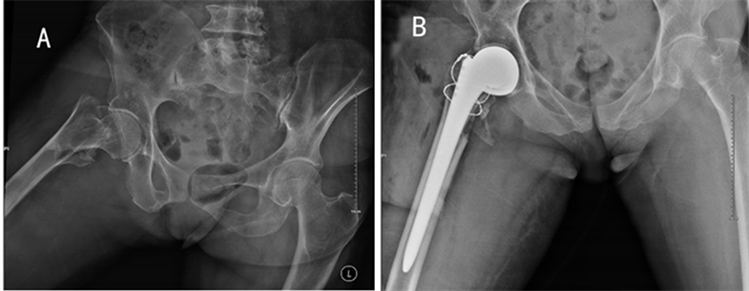摘要: 目的:探讨双极人工股骨头置换术在老年不稳定型股骨转子间骨折患者中的疗效及安全性。方法:回顾性分析2015年1月至2019年12月期间在我科收治的60例老年不稳定型股骨转子间骨折患者。受伤年龄75~90岁,平均81.3岁。按Evans-Jensen分型标准:IB型10例,IIA型14例,IIB型24例,III型12例。所有患者均接受人工股骨头置换治疗。结果:术后随访12~48个月(平均18.4个月),均获得随访。术后1例发生切口不愈合,经严格清创换药后痊愈;1例发生人工关节脱位,经二次手术后痊愈;1例出现钢丝断裂,但未见假体松动或脱位。末次随访未见畸形、脱位、假体周围骨折、假体松动及下沉等并发症。Harris评分从术前平均27.01 (范围:15~38)分,提高到末次随访时平均89.0 (范围:69~95)分;其中优38例,良11例,可10例,差1例,优良率81.6% (49/60)。结论:双极人工股骨头置换治疗老年不稳定型股骨转子间骨折的效果良好,可获得良好的骨折复位固定,且并发症少,安全性高。
Abstract:
Objective: To investigate the efficacy and safety of bipolar artificial femoral head replacement in the elderly patients with unstable intertrochanteric fractures. Methods: We retrospectively reviewed 60 elderly patients with unstable intertrochanteric fractures who were admitted to our department between January 2015 and December 2019. Age at injury ranged from 75 to 90 years, with a mean of 81.3. According to the Evans-Jensen classification criteria: 10 patients were type IB, 14 patients were type IIA, 24 patients were type IIB, and 12 patients were type III. All patients were treated with artificial femoral head replacement. Results: Patients were followed from 12 to 48 months (mean 18.4 months) after surgery and all were included in the study. After operation, 1 case had incision nonunion and recovered after strict debridement and dressing change; one case developed artificial joint dislocation and recovered after secondary operation; one case had steel wire fracture, but there was no prosthesis loosening or dislocation. No complications such as deformity, dislocation, periprosthetic fracture, prosthesis loosening and sinking were found in the last follow-up. The Harris score improved from a mean of 27.01 (range: 15~38) points preoperatively to a mean of 89.0 (range: 69~95) points at last follow-up; among them, 38 cases were excellent, 11 cases were good, 10 cases were fair, and 1 case was poor, with an excellent rate of 81.6% (49/60). Conclusions: The effect of bipolar artificial femoral head replacement in the treatment of the elderly unstable intertrochanteric fractures is good, and good fracture reduction and fixation can be obtained, with few complications and high safety.
1. 引言
随着我国人口老年化的发展和老年人户外活动的增加,股骨转子间骨折的病例数也在不断增加。在髋部骨折中,股骨转子间骨折就占45%,且有35%~40%是不稳定的三部分或四部分骨折,死亡率高 [1]。传统手术治疗以内固定为主,但存在内固定松动、退钉、断裂、螺钉切割股骨头及术后髋内翻等弊端 [2] [3]。人工关节置换术解决了传统手术的不足,且具有卧床时间短,出血量少,骨折不愈合等并发症发生率低等优势 [4] [5] [6]。该研究探讨了60例老年不稳定型股骨转子间骨折患者进行双极人工股骨头置换术(BA)的手术方法及疗效,现报告如下:
2. 资料与方法
2.1. 一般资料
回顾性分析2015年1月至2019年12月期间在新医大一附院关节外科收治的行人工股骨头置换术治疗的老年不稳定型股骨转子间骨折患者,共60例,其中男25例,女35例;受伤年龄75~97岁,平均年龄80.1岁。其中38例合并高血压、糖尿病、冠心病等内科疾病;2种或以上合并症者20例,所有患者均有不同程度的骨质疏松。骨折类型按Evans-Jensen分型 [7]:IB型10例,IIA型14例,IIB型24例,III型12例。
2.2. 资料选择
纳入标准:1) 年龄75岁以上,无其他关节疾病;2) 影像学检查证实转子间骨折且对侧髋关节功能良好者;3) 治疗方式为双极人工股骨头置换患者。
排除标准:1) 年龄在75岁以下者;2) 随访资料不完整者;3) 病理性骨折及合并严重肝肾及心脑血管疾病等不能手术患者;4) 拒绝双极人工股骨头置换手术患者。
3. 手术
3.1. 术前准备
入院后给予患者皮下注射低分子肝素钠预防下肢深静脉血栓形成,并行双下肢血管B超检查;给予止疼等对症处理;进行详细的体格检查和实验室检查,请相关科室会诊,评估耐受情况;确定骨折类型及特点,并评估患者骨质疏松程度,确保手术方案的可行性。手术前准备在入院后3~4天内完成。
3.2. 手术方法
术前30 min预防性使用抗生素。硬膜外麻醉后,患者均取侧卧位,采用后外侧入路。手术沿臀大肌纤维钝性分离组织,注意保护大转子骨折块与股骨上端相连的筋膜纤维,紧贴股骨粗隆间后缘骨皮质切断外旋短肌群附着点,分离显露关节囊并切开。随后于小转子上方1 cm处截断股骨颈,屈曲内旋髋关节使股骨颈断端脱出,螺旋取头器取出股骨头。修整股骨颈残端、探查髋臼是否完整及髓腔挫扩髓后,插入适配假体。所选用的假体为:非骨水泥型柄(北京春立正达医疗器械公司)或骨水泥型柄(LINK Cementless柄,德国)。牵引下肢并向髋臼方向压迫假体头,同时外旋股骨复位人工股骨头,并检测屈髋、内旋、外旋、外展、后伸等各方向有无脱位。满意后,最后行骨折端的复位和固定,纠正大转子旋转、移位及小转子重叠等情况。张力带或钛揽捆绑固定。冲洗术区,逐层关闭切口,所有患者均未放置引流。
3.3. 置换后处理
根据我院抗生素应用原则,置换后常规应用抗生素1~2 d。术后第2天复查X线片,若假体位置良好,嘱患者坐起并开始患肢肌肉静力性收缩功能锻炼。术后第二天根据术后复查凝血情况给予口服拜瑞妥,预防下肢深静脉血栓形成,术后第三天复查双下肢血管B超。术后5~7嘱开始借助助步器下床活动;
4. 结果
采用SPSS21.0统计软件进行分析。计量资料采用均数 ± 标准差表示,P < 0.05时认定为差异有统计学意义。手术患者使用非骨水泥型柄者21例(图1),非骨水泥型加长柄者28例(图2),骨水泥型柄者11例。术后随访12~48个月(平均18.4个月),均获得随访。术后1例发生切口不愈合,经严格清创换药后痊愈。1例发生人工关节脱位,经二次手术后痊愈;1例出现结扎钢丝断裂,但未见假体松动或脱位。末次随访未见畸形、脱位、假体周围骨折、假体松动及下沉等并发症。Harris评分 [8] 由手术前的平均27.01 (范围:15~38)分,提高到末次随访时平均89.0 (范围:69~95)分;其中优38例,良11例,可10例,差1例,优良率81.6% (49/60)。
5. 讨论
老年人股骨转子间骨折因患者多半有许多内科疾病、严重的骨质疏松、骨折后失去正常的解剖参考等原因而具有特殊性并加大手术的难度。传统的手术方法(内固定、动力髋螺钉等)虽具有较好的疗效,但是老年患者骨质疏松严重,骨折后多为粉碎性,采用内固定等方式,不仅骨折固定不牢靠,且有导致患者髋内翻、关节功能、负重能力差等术后并发症的风险。有文献报道过股骨转子间骨折DHS术后失败率28% (49/178) [9],同时许多文献报道了人工关节置换术对于老年不稳定型股骨转子间骨折有良好的治疗效果 [10] [11] [12] [13]。我科对于老年不稳定型股骨转子间骨折伴有骨质疏松的患者首先考虑人工关节置换术,并已获得了良好的治疗效果。笔者的体会如下:

Figure 1. The patient, female, 70 years old, had an intertrochanteric fracture of the left femur. A. Radiographs of the hip showed: Evans Jensen type IB. B. Radiographs after cementless (plain type) bipolar prosthetic femoral head replacement showed: satisfactory fracture reduction and good position of the prosthesis
图1. 患者,女,70岁,左侧股骨转子间骨折。A. 髋关节X线片示:Evans-Jensen IB型。B. 非骨水泥型(普通型)双极人工股骨头置换术后X线片示:骨折复位满意,假体位置良好

Figure 2. The patient, a 78-year-old woman, had an intertrochanteric fracture of the right femur. A. Radiographs of the hip showed: Evans Jensen type III. B. Radiographs after cementless bipolar prosthetic femoral head (plus long stem) replacement showed: satisfactory fracture reduction and good position of the prosthesis
图2. 患者女,78岁,右侧股骨转子间骨折。A. 髋关节X线片示:Evans-Jensen III型。B. 非骨水泥型双极人工股骨头(加长柄)置换术后X线片示:骨折复位满意,假体位置良好
1) 假体的选择,本组病例所选用的假体类型为骨水泥型柄、非骨水泥型加长柄及非骨水泥型全涂层矩形柄等。骨水泥型柄可获得骨折块原始固定的效果,降低手术难度,但对髓腔准备要求高,且转子间骨折因采用骨水泥粘合方式难以实现骨性愈合 [14];骨水泥柄本身也具有毒性作用 [15]。全髋置换术(THA)与双极股骨头置换术(BA)比较,THA手术出血量多,时间长,术后脱位率高,费用高 [16]。Alexander P. Sah等报道 [17],全髋关节置换的脱位率为22%,甚至高于翻修术。因此,笔者建议对于高龄、预期寿命短、功能要求不高的患者宜选择半髋置换。Lee YK等报道 [18],非骨水泥型全涂层加长柄人工股骨头置换具有长期稳定、并发症少、关节功能恢复快等优势。因长柄具有远端固定的作用,故对于骨折累积到大小转子致股骨矩破坏,并伴有严重的骨质疏松的患者选用加长柄人工股骨头置换效果更加。本组28例患者采用了非骨水泥型加长柄人工股骨头置换,随访结果效果满意。2) 截骨,宜先截骨,取出股骨头,如果先进行脱位再截骨取股骨头会加重原有骨折处的移位,导致出血、复位困难等问题。3) 扩髓,判断扩髓深度的方式可通过挫至合适深度时,放入合适的假体股骨柄试模,尝试性复位周围的骨块,以骨折复位是否能达到解剖复位来判断假体是否合适。4) 安装股骨柄,根据骨折类型及骨质疏松程度来选择合适型号的股骨柄及股骨头,人工关节复位后再复位骨折块,骨折块应尽量做到解剖复位,尤其是对于骨折累计股骨距的骨折块,应做到稳定牢固的解剖复位。5) 骨折块的固定,一般采用钛揽、钢丝张力带或钛制捆绑带固定。骨折端良好的复位和牢固的固定可以提高假体的稳定性,同时有利于保持臀中肌正常张力,从而能较好地保持人工关节的稳定性。我们认为,术后关节的稳定性和功能主要取决于外展肌群,而大转子是臀中肌等外展肌群的附着点,故大转子的解剖复位和牢固的固定至关重要。Yeesuk KIM等报道 [19],股骨内侧骨折块的稳定固定是必要的,以避免假体下沉。据文献报道 [20] ,用骨水泥技术、加长柄人工关节置换、股骨距和大小转子的解剖复位,可防止假体松动下沉、促进骨折愈合。张鹏等报道 [21],术中若行小粗隆复位及内固定,可增加手术创伤,且大多数小粗隆难以解剖复位。我们认为采用远端固定的加长柄人工股骨头置换时,小转子可不予处理(图1)。
综上所述,人工髋关节置换治疗老年不稳定型股骨转子间骨折效果良好,安全性高。大、小转子的解剖复位、牢固固定是术后髋关节稳定、保证功能的重要因素,采用远端固定的加长柄人工股骨头置换时,小转子可不予处理。综合考虑老年股骨转子间骨折不同的骨折类型及骨质疏松程度等多种因素选择合适的股骨柄是提高手术成功率,降低术后并发症的关键。
NOTES
*通讯作者。